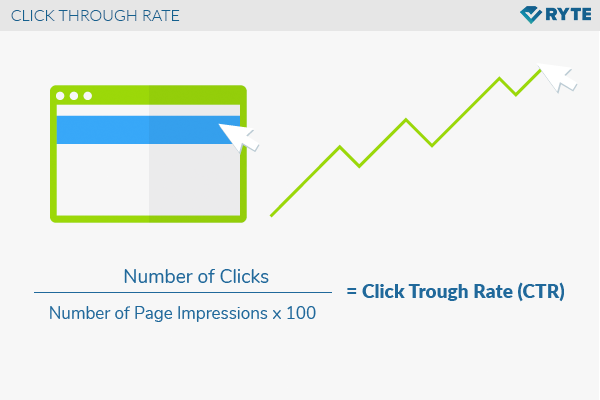Click Through Rate
Click-Through-Rate (or CTR for short) is an important KPI in Search Engine Optimization and other marketing channels like Email, used to measure the ratio of clicks a link received versus how many impressions or views the link had. For example, if a link with 1000 page impressions is clicked 23 times, it would result in a CTR of 2.3%. CTR helps SEOs evaluate if their search snippets are optimized well enough to guarantee an incoming click, and assist digital marketers in knowing if call-to-actions display the right messaging.
Calculation
The Click-Through-Rate can be calculated on the basis of a simple formula, clicks on the link divided by impressions of the link (i.e. how many saw it) multiplied by 100 to achieve a percentage.
There are many systems and tools that calculate a page or link's CTR automatically. When analyzing a page's SERP CTR, the SEO should rely on Google Search Console data which is direct information from the Search Engine giant themselves. To measure how a Search Engine ad is performing for each bid-on keyword, the information is found in the Google Ads dashboard.
Uses in Online Marketing
When CTR is mentioned in online marketing, it is always about the relationship of the clicks to views or impressions. Here are some of the many uses of the CTR KPI:
- Search Engine Advertising / PPC: CTR here refers to the relationship between the frequency of the displayed advertising media to the actual clicks on the advert. That can be a text advert, a shopping ad, or a display banner. The corresponding data can be evaluated through the Google Ads tool.
- Display advertising: When enabling adverts in a display advertising network, CTR helps measure how efficient the advertising media is and it's messaging. Additionally, CTR can help to put your CPM in perspective.
- Search Engine Optimization: for SEOs, the CTR plays an important role above all in the SERPs. Using this figure, you can recognize how appropriate the snippet is for the target group.
- Email Marketing: Using CTR or open rates helps to understand how eye-catching and relevant email subject text is. It's also important to use this KPI to see how users engage with the email messaging and whether they click on any used CTAs.
How to improve keyword and page CTR
In SEO, low click-through rates combined with high rankings can demonstrate that the page's snippet is not outstanding enough, and should therefore be optimized using a better meta title or meta description, or using Structured Data to enable a Rich Result. However, it could also mean that the page is irrelevant for the keyword, and therefore Google will readjust the rankings accordingly.
It is important to be aware of lower than required CTRs to make optimizations before the ranking is lost and to guarantee incoming traffic through searches. The Ryte Search Success module enables users to properly analyze Google Search Console data, but with far more keyword data and insights, including the CTRs with it. There is even the dedicated report, The CTR Underperformer report, which calculates expected CTRs and notifies users so that they can take action.
Using CTR to measure engagement
In correlation with time spent on page and bounce rate, the CTR can be seen as an important prerequisite for the generation of traffic to the website. However, with a certain keyword, the CTR is only relative. A CTR of 1% with 100,000 impressions means more visitors than a CTR of 10% with 1,000 visitors. When comparing CTRs across large keyword sets with varying intents or topics, it can be better to take amount of clicks or the increase of clicks as the best measurement.
CTR can also be impacted by content enrichments on the SERPs (Search Engine Result Pages) as Google may display quick answers to questions or Featured Snippets and therefore the click is not needed to a deeper page. For example, a keyword with direct informational intent, e.g. "what does CTR stand for" may yield a low CTR because the answer is easily found on the SERP.
References
What is Google Search Console?: https://search.google.com/search-console/about
Google Ads definition of CTR: https://support.google.com/google-ads/answer/2615875
Advice on improving organic CTR: https://en.ryte.com/product-insights/optimize-ctr-ryte

